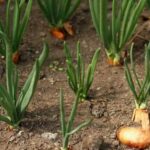Mushroom compost in vegetable gardens has become increasingly popular among gardeners looking for an organic and sustainable way to nourish their plants. Mushroom compost, also known as mushroom soil or mushroom substrate, is a type of organic matter that is created from the byproducts of mushroom cultivation. This nutrient-rich material offers numerous benefits for vegetable gardens, including improved soil structure, increased microbial activity, and a boost in essential nutrients.
Created through a process that involves combining materials like straw, horse manure, gypsum, and agricultural lime, mushroom compost undergoes several weeks of decomposition and pasteurization before it is suitable for use in gardens. This process not only eliminates pathogens and harmful microbes but also transforms the raw ingredients into a potent source of nutrition for plants.
In this article, we will explore the process of making mushroom compost and delve into its nutritional benefits for vegetables. We will also provide practical guidance on how to incorporate mushroom compost into a vegetable garden and offer tips on maintaining healthy plant growth.
Additionally, we will address common misconceptions about using mushroom compost in vegetable gardens and share real-life success stories that showcase the positive impact of this organic soil amendment. Whether you are a seasoned gardener or just starting out with your first vegetable garden, understanding the advantages of mushroom compost can significantly enhance the health and productivity of your crops.
The Process of Making Mushroom Compost
Mushroom compost is a valuable resource that many gardeners use to improve the health and productivity of their vegetable gardens. This nutrient-rich organic material is created through a carefully managed process that transforms raw materials such as straw, gypsum, and poultry litter into a beneficial amendment for soil. Understanding the steps involved in making mushroom compost can provide insight into its unique properties and benefits for vegetable plants.
The process of creating mushroom compost begins with the combination of organic materials such as straw, corn cobs, and other agricultural by-products. These materials are mixed with nitrogen-rich supplements like poultry litter or horse manure to create a balanced blend of carbon and nitrogen.
Once combined, the mixture is pasteurized to eliminate any harmful pathogens or weed seeds that may be present. This controlled heating process also facilitates the breakdown of organic matter and prepares it for colonization by beneficial microorganisms.
After pasteurization, the material is then inoculated with mushroom spawn, which introduces fungal mycelium to the composting substrate. Over a period of several weeks, the mycelium colonizes the organic matter, breaking it down and transforming it into a rich, dark brown compost known as mushroom compost. The finished product is then cured and stabilized before being used as an amendment in vegetable gardens.
One of the key benefits of using mushroom compost in vegetable gardens is its ability to improve soil structure, water retention, and nutrient availability. Additionally, mushroom compost contains significant levels of essential nutrients such as potassium, phosphorus, and magnesium, which are beneficial for the growth and development of vegetable plants. Its high organic matter content also encourages beneficial microbial activity in the soil, promoting overall soil health and fertility.
| Advantages | Data |
|---|---|
| Nutrient Content | Potassium, phosphorus,magnesium |
| Soil Health | Promotes microbial activity |
| Soil Structure | Improves water retention |
Nutritional Benefits of Mushroom Compost for Vegetables
Essential Nutrients in Mushroom Compost
Mushroom compost is a rich source of essential nutrients and minerals that are beneficial for the growth and development of vegetable plants. Some of the key nutrients found in mushroom compost include nitrogen, phosphorus, potassium, calcium, magnesium, and sulfur. These nutrients are vital for promoting healthy root development, strong stems, and vibrant foliage in vegetable plants. Additionally, mushroom compost also contains micronutrients such as iron, copper, zinc, and manganese, which are important for overall plant health and disease resistance.
Beneficial Microorganisms
In addition to essential nutrients, mushroom compost also provides a diverse array of beneficial microorganisms that contribute to the overall soil health in vegetable gardens. These microorganisms help to break down organic matter, improve soil structure, and enhance nutrient availability for plant roots. The presence of these microorganisms can lead to increased nutrient uptake by vegetable plants, resulting in healthier growth and higher yields.
Improvement of Soil Structure
One of the unique benefits of using mushroom compost in vegetable gardens is its ability to improve soil structure. The organic matter in mushroom compost helps to loosen compacted soils and increase drainage, which is particularly advantageous for vegetable plants that prefer well-draining soil conditions.
Moreover, the addition of mushroom compost can also aid in water retention, ensuring that vegetable plants have access to adequate moisture during dry periods. The improved soil structure provided by mushroom compost creates a favorable environment for root development and overall plant growth.
By incorporating mushroom compost into your vegetable garden’s soil, you can ensure that your plants receive the essential nutrients they need for healthy growth while also improving the overall health and productivity of your garden.
How to Use Mushroom Compost in Vegetable Gardens
Mushroom compost is a natural, organic material that has numerous benefits for vegetable gardens. It provides essential nutrients, improves soil structure, and enhances water retention, making it an ideal choice for cultivating healthy and thriving vegetable plants. In this section, we will discuss the step-by-step process of incorporating mushroom compost into a vegetable garden to reap its many benefits.
Before using mushroom compost in your vegetable garden, it’s important to ensure that the compost has been properly aged and does not contain any harmful pathogens. Once you have obtained high-quality mushroom compost, the first step is to prepare the soil in your garden bed. You can do this by removing any weeds or debris and loosening the soil to improve aeration.
Next, determine the appropriate amount of mushroom compost to add to your garden bed. A general guideline is to incorporate 1-2 inches of compost into the top 6-8 inches of soil. Use a shovel or garden fork to mix the compost thoroughly with the soil, ensuring an even distribution.
After incorporating mushroom compost into the soil, it’s essential to water the garden bed thoroughly. This will help activate the beneficial microorganisms present in the compost and promote nutrient uptake by the plants. Once the mushroom compost has been incorporated and watered, you can proceed with planting your desired vegetable crops.
For best results, consider adding a layer of mulch on top of the amended soil to conserve moisture and suppress weed growth. Additionally, regular monitoring and proper maintenance of moisture levels will help maximize the benefits of using mushroom compost in your vegetable garden.
| Steps | Description |
|---|---|
| Prepare Garden Bed | Remove weeds/debris & loosen soil |
| Incorporate Compost | Add 1-2 inches into top 6-8 inches of soil & mix thoroughly |
| Water Thoroughly | Activate microorganisms & promote nutrient uptake |
Best Vegetables to Grow With Mushroom Compost
When it comes to using mushroom compost in vegetable gardens, certain vegetables are particularly well-suited to benefit from this nutrient-rich soil amendment. The unique blend of organic materials and beneficial microorganisms found in mushroom compost can significantly enhance the growth, flavor, and overall health of certain vegetable crops. Here are some of the best vegetables to grow with mushroom compost:
Tomatoes
Tomatoes are known for their heavy nutrient requirements, especially for phosphorus and potassium. Mushroom compost provides a balanced source of these essential nutrients, as well as important micronutrients such as calcium, magnesium, and zinc. When used as a part of the soil mixture for tomatoes, mushroom compost can lead to increased fruit production, improved taste, and better disease resistance.
Peppers
Similar to tomatoes, peppers also thrive when grown in soil amended with mushroom compost. The rich organic matter helps retain moisture while promoting healthy root development. Additionally, the beneficial microorganisms present in mushroom compost can aid in the breakdown of organic matter in the soil, releasing valuable nutrients that are essential for pepper plants’ growth and productivity.
Leafy Greens
Leafy green vegetables such as lettuce, spinach, kale, and Swiss chard can greatly benefit from the use of mushroom compost in vegetable gardens. The high nitrogen content in mushroom compost supports robust leafy green growth while also improving soil structure and water retention capabilities. Additionally, the presence of beneficial microorganisms can help suppress diseases that commonly affect leafy greens.
By incorporating mushroom compost into the soil for these specific vegetable crops, gardeners can expect healthier plants, increased yields, and improved overall garden performance. It’s important to note that while these vegetables are particularly well-suited for growing with mushroom compost, many other vegetable varieties can also benefit from its use.
Tips for Maintaining a Healthy Vegetable Garden With Mushroom Compost
When it comes to maintaining a healthy vegetable garden with mushroom compost, there are several key tips and strategies to keep in mind. By following these guidelines, gardeners can ensure that their vegetable plants receive the maximum benefits from the nutrient-rich mushroom compost.
Here are some essential tips for using mushroom compost in vegetable gardens:
1. Properly integrate the mushroom compost into the soil: One of the first steps in using mushroom compost in a vegetable garden is to thoroughly mix it into the soil. This ensures that the nutrients and beneficial microorganisms are evenly distributed, providing an optimal growing environment for vegetables.
2. Monitor moisture levels: Mushroom compost has excellent water retention properties, but it’s important to monitor moisture levels regularly. Excessive dryness or waterlogging can be detrimental to plant health, so be sure to adjust watering as needed.
3. Rotate crops: To maximize the benefits of mushroom compost in a vegetable garden, consider rotating crops each season. This helps prevent nutrient depletion and minimizes disease and pest issues.
Additionally, gardeners should also be mindful of not over-applying mushroom compost. While this organic material provides numerous benefits, excessive use can lead to nutrient imbalances and adversely affect plant growth. By following these tips, individuals can maintain a healthy and productive vegetable garden with mushroom compost while minimizing potential pitfalls or challenges along the way.
Common Misconceptions About Mushroom Compost in Vegetable Gardens
Many gardeners may have misconceptions about using mushroom compost in vegetable gardens, which can lead to hesitation in incorporating this beneficial amendment into their gardening practices. It is important to address these myths and misunderstandings to ensure that gardeners feel confident in utilizing mushroom compost for their vegetable gardens.
One common misconception about mushroom compost in vegetable gardens is that it will introduce harmful chemicals or toxins into the soil and therefore affect the quality of the vegetables grown. However, when properly produced and aged, mushroom compost is a safe and organic material that is free from harmful substances. In fact, mushroom compost is often known for its ability to improve soil structure and fertility without negatively impacting plant growth or health.
Another myth surrounding the use of mushroom compost in vegetable gardens is that it may introduce unwanted pests or diseases to the garden. In reality, high-quality mushroom compost undergoes a hot composting process that eliminates pathogens, weed seeds, and insect eggs. This ensures that the finished product is free from potential pests or diseases that could harm vegetable plants.
Many gardeners also believe that using mushroom compost in vegetable gardens will result in an unpleasant odor that lingers in the garden. While fresh mushroom compost may have a distinct earthy smell, properly aged and cured mushroom compost has a mild odor that dissipates quickly once applied to the soil. Moreover, the benefits of using mushroom compost far outweigh any temporary odor concerns, making it a valuable addition to any vegetable garden.
- Utilize multiple sources of information before purchasing or applying any type of soil amendment
- Follow recommended application rates when incorporating mushroom compost into your vegetable garden
- Monitor plant growth and soil health after introducing mushroom compost to gauge its effectiveness
It’s important for gardeners to be well-informed about the benefits and proper use of mushroom compost in vegetable gardens to make informed decisions about their gardening practices. By debunking these misconceptions and addressing concerns, more individuals can confidently reap the advantages of using this nutrient-packed amendment for their vegetable gardens.
Case Studies and Success Stories of Using Mushroom Compost in Vegetable Gardens
In conclusion, mushroom compost is a valuable and effective resource for vegetable gardens, providing numerous benefits for plant growth and soil health. The process of making mushroom compost involves the decomposition of various organic materials, resulting in a nutrient-rich amendment that can enhance the overall health and yield of vegetable plants. With its abundance of beneficial nutrients and minerals, mushroom compost offers an ideal solution for improving the quality of soil in vegetable gardens.
When properly incorporated into the soil, mushroom compost can significantly improve the growth and productivity of a wide variety of vegetables. From tomatoes to cucumbers to leafy greens, many types of vegetables thrive when grown with mushroom compost. By following a step-by-step guide for using mushroom compost in vegetable gardens, gardeners can ensure that their plants receive the full nutritional benefits of this organic amendment.
Overall, it is essential for gardeners to understand the proper techniques for using mushroom compost in vegetable gardens to maximize its effectiveness. By addressing common misconceptions and providing practical tips for maintenance, gardeners can ensure the long-term health and productivity of their vegetable gardens with the help of mushroom compost.
Furthermore, real-life case studies and success stories serve as powerful testimonials to the positive impact that mushroom compost can have on vegetable gardens, encouraging others to consider incorporating this valuable resource into their own gardening practices.
Frequently Asked Questions
Is Mushroom Compost Good for a Vegetable Garden?
Mushroom compost can be beneficial for a vegetable garden as it adds nutrients to the soil and improves its structure. It also helps retain moisture and suppresses weeds, making it an ideal option for organic gardening.
What Are the Disadvantages of Mushroom Compost?
One potential disadvantage of using mushroom compost is that it can be quite alkaline, which may not be suitable for all types of plants. Additionally, if not properly pasteurized, it can contain pathogens or weed seeds that may harm the garden.
Is Mushroom Compost OK for Tomatoes?
Yes, mushroom compost is generally okay for tomatoes as it can provide them with the necessary nutrients and improve soil quality. However, it is important to ensure that the compost has been properly processed to avoid any potential risks such as diseases or excessive alkalinity.

If you’re looking to get into vegetable gardening, or are just looking for some tips on how to make your current garden better, then you’ve come to the right place! My name is Ethel and I have been gardening for years. In this blog, I’m going to share with you some of my best tips on how to create a successful vegetable garden.





